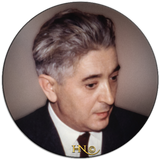Printmaking Technique
Using an original drawing (often a pen and ink drawing) as an inspiration or general guide, Hnizdovsky begins a series of preliminary sketches on tracing paper. Each successive image is refined toward the stylization he wishes the final design to take. Strict attention is paid to detail, nuance, balance of mass, black and white distribution. The number of preliminary drawings at this stage may vary from between six and twenty (all on tracing paper). Once a drawing is completed to his satisfaction, it is ready to be transferred to the woodblock.
For the transfer of the drawing to the woodblock, Hnizdovsky prefers to use a simple sheet of carbon paper. The master drawing is placed face down (in reverse) on the carbon paper, and the design is traced with a pencil from the back of the tracing vellum. As Hnizdovsky traces, he continues to refine and strengthen the overall design. Perhaps some lines require thickening while others may need to be lightened. The object at this stage is not only to transfer, but to improve and refine the linear quality of the drawing. When the entire drawing has been traced, the copy paper and tracing vellum are removed. The carbon lines on the woodblock are intensified with India ink. Redrawing in India ink with a dip pen is for permanence and also provides a fluid, not mechanical line. As Hnizdovsky draws onto the woodblock with pen and ink, he further strengthens the structure of the drawing. The result is a beautiful, fluid-lined pen and ink drawing in reverse, a drawing where the white spaces will soon be chiseled away from the block.

Hnizdovsky’s woodcutting tools are simple: a sharp pointed flat blade (to chisel away large areas), and various V and U shaped gouges for detailed work.

The time involved in the actual cutting of the woodblock depends on two factors, the size of the image and its complexity. Most of his larger woodcuts entail weeks of cutting, some extremely detailed prints may take months.

The woodblocks are of a hardwood such as cherry, pear, beech or apple. While Hnizdovsky favors the hardness of pear wood for his extremely intricate and detailed woodcuts, for prints with larger areas of black and white, and for prints with softer, rounder lines, he chooses the soft pliable quality of linoleum.

As Hnizdovsky carves, whether in wood or linoleum, he again uses his carving tools as a free-hand drawing instrument, often veering from the beautifully drawn pen and ink under-drawing. This gives his prints fluidity and vitality.
Inking, proofing and printing an entire edition requires weeks of painstaking work. Hnizdovsky would first print five to ten trial proofs, reviewing each print, looking for areas that are too dense, or need refinement. He would stand with his U & V shaped woodcutting tools in hand, ready to carve out a little here, a little there. Sometimes the background was not adequately low and printed black streaks onto the white paper (Washi). He would need to chisel away these overly high areas to create a clean white background. These first prints, the T.P.s, even with their slight idiosyncrasies, and frequently unbalanced lines, are highly sought out by collectors, since they provide an inner view into the artist's creative process.

Once Hnizdovsky is satisfied with the trial proofs, he proceeds to print the artist’s proofs, an edition of approximately 20. Hnizdovsky then proceeds to print the limited edition of between 100 and 150 prints. Clotheslines zig-zagged through Hnizdovsky's print studio, where he would hang his prints to dry. Once the prints were dry, he would sign them with the title and year the print was created, mark T.P on the Trial proofs, A.P. and the edition number on the Artist's Proofs, and then proceed to sign the limited edition, numbering each print sequentially. Hnizdovsky had a tin box full of hundreds of stubby, but fully sharpened pencils, which were ready for his print signing ritual.

For many years all of Hnizdovsky’s blocks were printed by the hand and spoon method, which was very laborious. Heat from the spoon rubbing against Washi would often tear the delicate handmade Japanese mulberry paper Hnizdovsky used for his prints. An additional problem with the hand and spoon method, was the issue of ink drying too quickly. Ink could not be made more viscous and less quick drying, as it would then settle into the grooves of his woodblocks and create blotches. The hand and spoon printing method was extremely time consuming and laborious, and these early prints were often lighter in tone than later prints due to ink drying. After developing severe bursitis from the pressure needed to spoon print an entire edition, Hnizdovsky was forced to acquire a manual hand-cranked press, which enabled him to continue printing his woodcuts, linocuts and exhibition posters.
Hnizdovsky printed all of his prints in his home studio (his converted garage). The only exceptions were the larger etchings, which were printed in the studio of master printer Emiliano Sorini under Hnizdovsky’s direct supervision (Jacques Hnizdovsky lacked the very large etching press needed to print them). Hnizdovsky’s smaller etchings were all printed at home.
